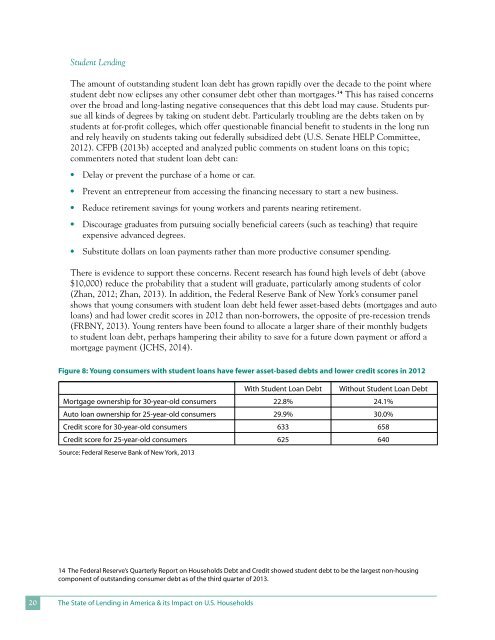You also want an ePaper? Increase the reach of your titles
YUMPU automatically turns print PDFs into web optimized ePapers that Google loves.
Student Lending<br />
<strong>The</strong> amount <strong>of</strong> outstanding student loan debt has grown rapidly over the decade to the point where<br />
student debt now eclipses any other consumer debt other than mortgages.14 This has raised concerns<br />
over the broad and long-lasting negative consequences that this debt load may cause. Students pursue<br />
all kinds <strong>of</strong> degrees by taking on student debt. Particularly troubling are the debts taken on by<br />
students at for-pr<strong>of</strong>it colleges, which <strong>of</strong>fer questionable financial benefit to students in the long run<br />
and rely heavily on students taking out federally subsidized debt (U.S. Senate HELP Committee,<br />
2012). CFPB (2013b) accepted and analyzed public comments on student loans on this topic;<br />
commenters noted that student loan debt can:<br />
• Delay or prevent the purchase <strong>of</strong> a home or car.<br />
• Prevent an entrepreneur from accessing the financing necessary to start a new business.<br />
• Reduce retirement savings for young workers and parents nearing retirement.<br />
• Discourage graduates from pursuing socially beneficial careers (such as teaching) that require<br />
expensive advanced degrees.<br />
• Substitute dollars on loan payments rather than more productive consumer spending.<br />
<strong>The</strong>re is evidence to support these concerns. Recent research has found high levels <strong>of</strong> debt (above<br />
$10,000) reduce the probability that a student will graduate, particularly among students <strong>of</strong> color<br />
(Zhan, 2012; Zhan, 2013). In addition, the Federal Reserve Bank <strong>of</strong> New York’s consumer panel<br />
shows that young consumers with student loan debt held fewer asset-based debts (mortgages and auto<br />
loans) and had lower credit scores in 2012 than non-borrowers, the opposite <strong>of</strong> pre-recession trends<br />
(FRBNY, 2013). Young renters have been found to allocate a larger share <strong>of</strong> their monthly budgets<br />
to student loan debt, perhaps hampering their ability to save for a future down payment or afford a<br />
mortgage payment (JCHS, 2014).<br />
Figure 8: Young consumers with student loans have fewer asset-based debts and lower credit scores in 2012<br />
With Student Loan Debt Without Student Loan Debt<br />
Mortgage ownership for 30-year-old consumers 22.8% 24.1%<br />
Auto loan ownership for 25-year-old consumers 29.9% 30.0%<br />
Credit score for 30-year-old consumers 633 658<br />
Credit score for 25-year-old consumers 625 640<br />
Source: Federal Reserve Bank <strong>of</strong> New York, 2013<br />
14 <strong>The</strong> Federal Reserve’s Quarterly Report on Households Debt and Credit showed student debt to be the largest non-housing<br />
component <strong>of</strong> outstanding consumer debt as <strong>of</strong> the third quarter <strong>of</strong> 2013.<br />
20<br />
<strong>The</strong> State <strong>of</strong> Lending in America & its Impact on U.S. Households


